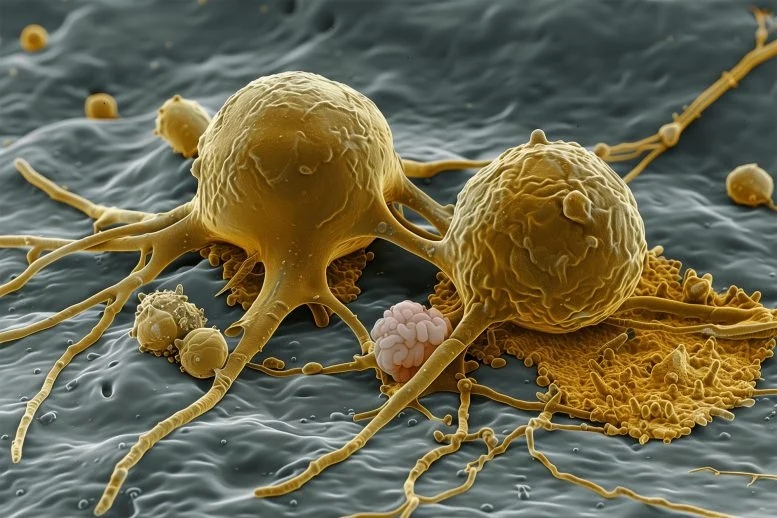博文
科学家发现工程细菌如何增强免疫系统以杀死癌症
 精选
精选
||
科学家发现工程细菌如何增强免疫系统以杀死癌症
诸平
据《科技日报》(scitechdaily)网站刊发来自中国科学院(Chinese Academy Of Sciences)2025年3月3日提供的消息,科学家们发现了工程细菌是如何增强免疫系统来杀死癌症的(Scientists Discover How Engineered Bacteria Supercharge the Immune System to Kill Cancer)。
几十年来,科学家们一直在探索细菌对抗癌症的潜力,但安全性和有效性方面的障碍一直是阻碍。现在,一个研究小组已经破解了基因工程细菌(特别是DB1)如何选择性地靶向和消除肿瘤的密码。(For decades, scientists have explored the potential of bacteria in fighting cancer, but safety and efficacy barriers have stood in the way. Now, a research team has cracked the code behind how genetically engineered bacteria, specifically DB1, can selectively target and eliminate tumors.)
由中国科学院深圳先进技术研究院{Shenzhen Institutes of Advanced Technology at the Chinese Academy of Sciences (CAS)}的刘陈立教授(Prof. Chenli Liu)和CAS上海营养与健康研究所(Shanghai Institute of Nutrition and Health at CAS)的肖意传教授(Prof. Yichuan Xiao)领导的一个研究小组,发现了利用基因工程菌株治疗细菌癌症的关键机制。相关研究结果于2025年3月3日已经在《细胞》(Cell)杂志网站发表——Zhiguang Chang, Xuan Guo, Xuefei Li, Yan Wang, Zhongsheng Zang, Siyu Pei, Weiqi Lu, Yang Li, Jian-Dong Huang, Yichuan Xiao, Chenli Liu. Bacterial immunotherapy leveraging IL-10R hysteresis for both phagocytosis evasion and tumor immunity revitalization. Cell, 3 March 2025. DOI: 10.1016/j.cell.2025.02.002. https://doi.org/10.1016/j.cell.2025.02.002
利用细菌对抗癌症的想法可以追溯到19世纪60年代。然而,尽管历史悠久,但由于对安全性和有效性的担忧,基于细菌的癌症治疗一直难以获得临床牵引力。
合成生物学的挑战与创新(Challenges and Innovations in Synthetic Biology)
合成生物学的最新进展导致了新型抗肿瘤细菌的产生,为免疫肿瘤学(immuno-oncology)开辟了新的可能性。然而,一个主要的挑战仍然存在:了解这些细菌如何逃避人体免疫系统,同时激活抗肿瘤反应。
在这项研究中,研究人员开发了一种被称为设计细菌1(Designer Bacteria 1简称DB1)的工程菌株。该菌株被设计为在肿瘤组织中茁壮成长,同时从健康组织中消除,实现了高度靶向的肿瘤治疗方法和有效的肿瘤清除效果。
揭示CD8+ TRM细胞的作用(Unraveling the Role of CD8+ TRM Cells)
为了了解DB1如何同时达到这些效果,研究人员研究了细菌和肿瘤之间的相互作用。他们发现DB1的抗肿瘤功效与肿瘤内的组织驻留记忆(tissue-resident memory简称TRM) CD8+ T细胞密切相关,这些细胞在DB1治疗后被重新激活和扩大。白细胞介素-10(Interleukin-10简称IL-10)在介导这种效应中起着至关重要的作用,其疗效取决于白细胞介素-10受体(interleukin-10 receptor简称IL-10R)在CD8+ TRM细胞上的高表达。
IL-10反馈回路与肿瘤记忆(The IL-10 Feedback Loop and Tumor Memory)
为了研究IL-10R在CD8+ TRM细胞高表达的分子机制,研究人员进行了一系列计算和定量实验。他们发现,IL-10与CD8+ TRM细胞上的IL-10R结合,激活STAT3蛋白,进一步促进IL-10R的表达。这建立了一个正反馈回路,使细胞结合更多的IL-10,并产生非线性滞后效应,即CD8+ TRM细胞在肿瘤发生过程中记住先前的IL-10刺激。IL-10R在CD8+ TRM细胞上的高表达是通过细菌诱导的IL-10激增来激活和扩增CD8+ TRM细胞以清除肿瘤细胞。
肿瘤微环境与免疫系统调节(Tumor Microenvironment and Immune System Modulation)
为了研究细菌治疗后肿瘤微环境(tumor microenvironment简称TME)中IL-10的来源,研究人员发现肿瘤相关巨噬细胞(tumor-associated macrophages简称TAMs)在DB1刺激后通过Toll样受体4(Toll-like Receptor 4简称TLR4)信号通路上调IL-10的表达。有趣的是,IL-10降低了肿瘤相关中性粒细胞(tumor-associated neutrophils简称TANs)的迁移速度,帮助DB1逃避快速清除。这些过程依赖于肿瘤相关免疫细胞中IL-10R的高表达,突出了IL-10R迟滞的关键作用。
细菌性癌症治疗的新途径(A New Path for Bacterial Cancer Therapy)
刘陈立教授说:“我们的发现阐明了细菌癌症治疗中一个关键的,但以前未解决的机制。IL-10R的迟滞机制不仅提供了有价值的见解,而且为工程细菌的设计提供了指导原则,提高了安全性和有效性。”
上述介绍仅供参考,欲了解更多信息敬请注意浏览原文和相关报道。
Cell | 刘陈立/肖意传团队揭示合成生物细菌肿瘤疗法关键原理.网易号, 2025-03-04
Bacterial immunotherapy holds promising cancer-fighting potential. However, unlocking its power requires a mechanistic understanding of how bacteria both evade antimicrobial immune defenses and stimulate anti-tumor immune responses within the tumor microenvironment (TME). Here, by harnessing an engineered Salmonella enterica strain with this dual proficiency, we unveil an underlying singular mechanism. Specifically, the hysteretic nonlinearity of interleukin-10 receptor (IL-10R) expression drives tumor-infiltrated immune cells into a tumor-specific IL-10Rhi state. Bacteria leverage this to enhance tumor-associated macrophages producing IL-10, evade phagocytosis by tumor-associated neutrophils, and coincidently expand and stimulate the preexisting exhausted tumor-resident CD8+ T cells. This effective combination eliminates tumors, prevents recurrence, and inhibits metastasis across multiple tumor types. Analysis of human samples suggests that the IL-10Rhi state might be a ubiquitous trait across human tumor types. Our study unveils the unsolved mechanism behind bacterial immunotherapy’s dual challenge in solid tumors and provides a framework for intratumoral immunomodulation.
https://wap.sciencenet.cn/blog-212210-1475916.html
上一篇:氰化物:我们细胞所必需的有毒气体
下一篇:新工具彻底改变了传染病检测的引物设计
